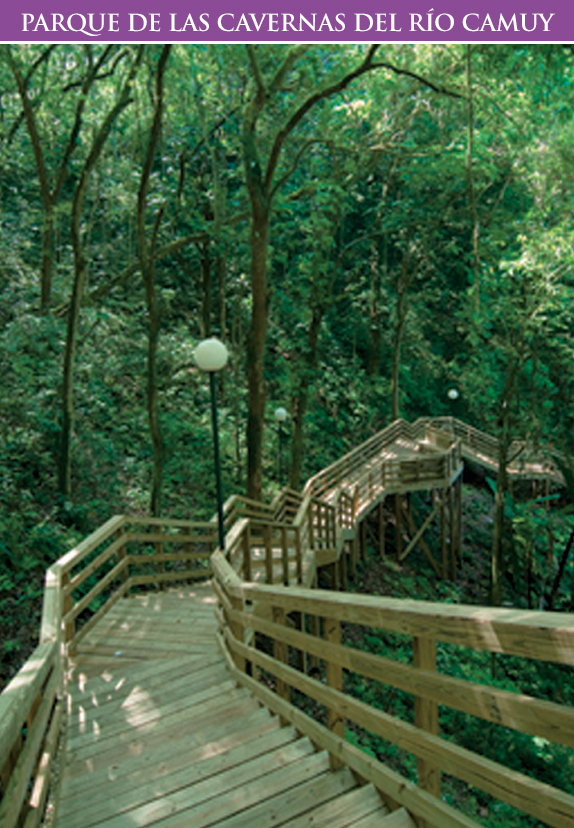
Parque de las Cavernas del Rio Camuy
This park comprises part of the world’s third-largest cave system, Cavernas del Río Camuy, which has more than 220 underground caverns. One of the chambers is so large, it could swallow a 30-story building. Spotlights illuminate fantastic stalactites, stalagmites, and other dripstone formations, some of which are etched with pre-Columbian Taíno motifs. Bats flit about overhead, tarantulas crawl underfoot, and a blind endemic fish species swims in the underground river, Río Camuy. These caves were only discovered in the 1950s and are today under the care of Puerto Rico’s Compañia de Parques Nacionales. Carretera 129 Km 18.9, Camuy • 787 898 3100 • Open 8:30am–5pm Wed–Sun & holidays • Adm $15 for adults; $10 for children (4–12 years)
Carretera 129 Km 18.9, Camuy • 787 898 3100 • Open 8:30am–5pm Wed–Sun & holidays • Adm $15 for adults; $10 for children (4–12 years)
1. Cueva Clara de Enpalma
This massive cavern soars 170 ft (52 m) high and extends lengthways for more than 1,970 ft (600 m) to a vast sinkhole – the Sumidero Enpalma. Concrete paths snake along the cavern’s floor, providing a fascinating loop trail.
2. Taino Pictographs
Ancient indigenous people daubed symbolic spiritual figures onto the cave walls using mixtures of charcoal, bat droppings, and animal fat. These have survived millennia thanks to the natural humidity and coolness of the caverns.
3. Dripstone Formations
Many of the stalactites, stalagmites, and other calcite formations in the caves resemble familiar shapes, such as animals and church organs. Visitors will have fun identifying the forms, some of which are floodlit.
4. Trolley Ride
Your visit begins with a ride in a trolley that snakes downhill past bamboo and banana trees to the cave entrance. The return journey passes by the Tres Pueblo Sinkhole.
5. Tres Pueblo Sinkhole
This massive depression plunges 400 ft (120 m) and was formed when the ceiling of an underground cavern collapsed. The Río Camuy at its base can be seen emerging from one cavern and entering another.
6. Bats
More than 100,000 bats roost in the caves, where they cling to rooftop crevices by day, before swarming out in hordes at dusk to forage for insects.
7. Rio Camuy
This river weaves its way through the cave system. It has been carving out the subterranean landscape for millions of years, assisted by rainwater that seeps into the limestone, weakening the structural joints.
8. Tarantulas
These huge, hairy, long-legged spiders are numerous in the cool, damp interior of the caves. They play an important part in the local ecology and are harmless unless provoked.
9. Cueva Catedral
This cavern contains more than 40 pre-Columbian pictographs. Reaching the entrance requires a rappel down a rock wall and should be arranged with local tour operators.
10. Visitor Center
Information panels are on display in the timber-and-fieldstone visitor center. A short film on the cavern system and its formation is shown prior to the guided tour.
Sacred Caverns
The Taíno never lived in caves, which they considered sacred portals to the spirit world. They drew pictures of fearsome gods to guard the entrances, and only high-ranking community figures, like shamans, were allowed to enter. These people believed that their ancestral spirits lived in caves and only emerged at night to eat fruits. Legend has it that the spirits were so occupied in gorging themselves that they were still outside the caves when the sun came up, turning them into human beings.
 Tip: The walkways can get slippery, so wear comfortable shoes with good grip. A sweater or light jacket can come in handy against the chill of the caverns.
Tip: The walkways can get slippery, so wear comfortable shoes with good grip. A sweater or light jacket can come in handy against the chill of the caverns. Tip: The visitor center has a snack bar and the gift shop sells snacks. A campsite in the park has toilets and showers.
Tip: The visitor center has a snack bar and the gift shop sells snacks. A campsite in the park has toilets and showers.


